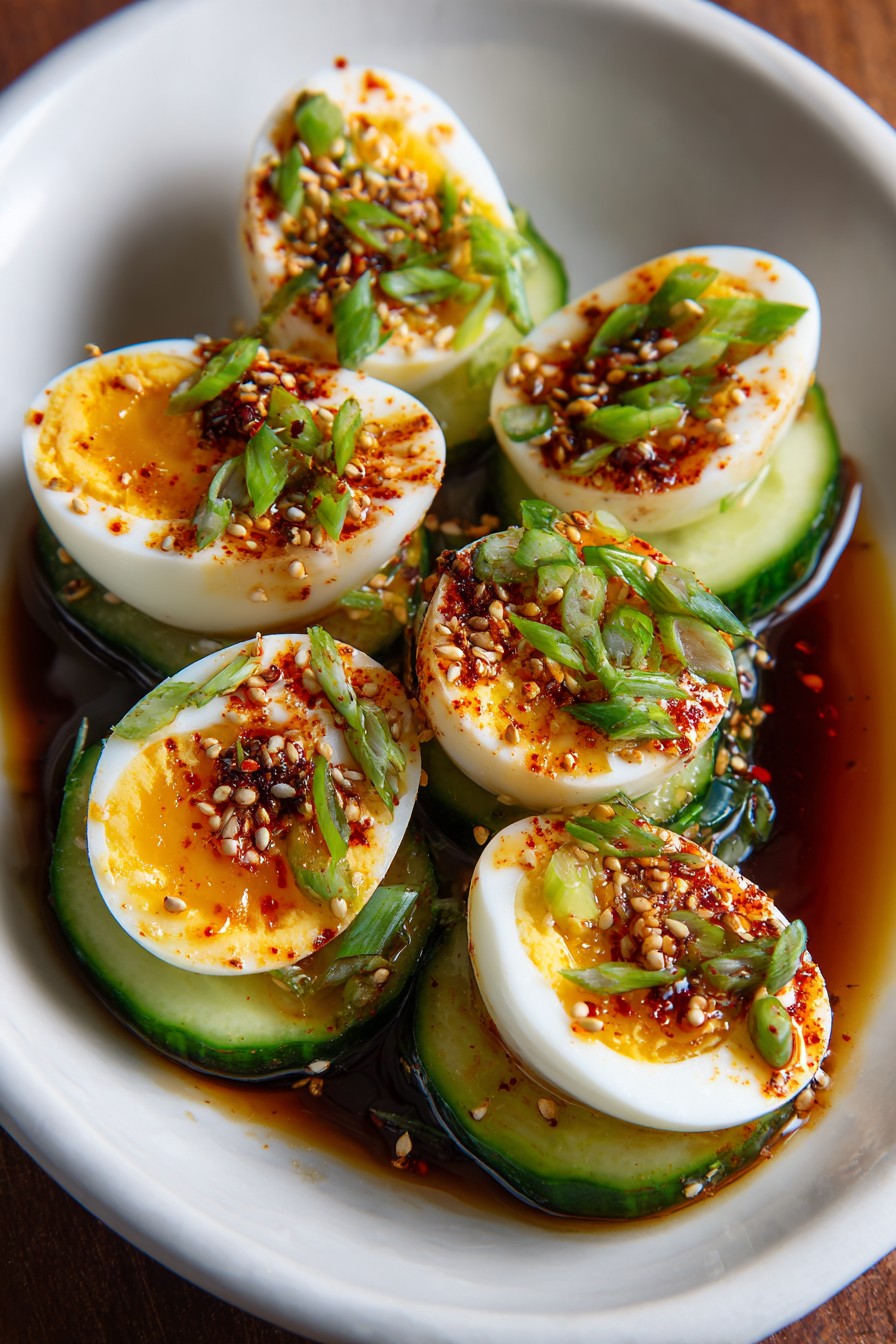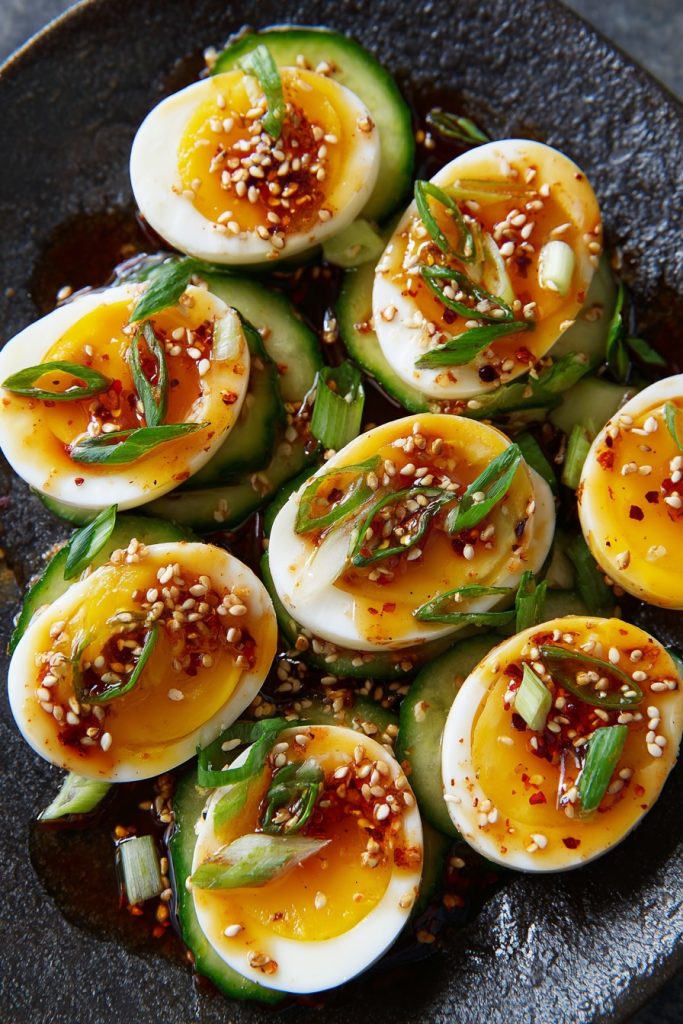Now imagine waking to the sizzle of garlic and soy in a Seoul morning market, where street vendors craft these savory eggs that bridge ancient royal cuisine with modern breakfast tables. Nothing captures Korea’s culinary soul quite like these perfectly seasoned eggs, where each bite transports you through centuries of flavor evolution from palace kitchens to contemporary brunch spots.
Why This Recipe Works
- The magic begins with the soy-mirin marinade that penetrates deep into the egg whites, creating layers of umami that recall the fermented foundations of Korean cooking while maintaining the delicate texture of perfectly cooked yolks
- By gently simmering rather than boiling aggressively, we preserve the custard-like consistency prized in traditional Korean banchan, where texture matters as much as flavor in creating harmonious meals
- The final sesame oil drizzle connects directly to Korea’s agricultural heritage, adding nutty depth that complements the soy-based marinade in the same way sesame enhances bibimbap and other classic dishes
- Quick-pickled vegetables provide the essential crunchy contrast found throughout Korean cuisine, balancing richness with brightness in true yin-yang fashion
- Using both fresh and dried aromatics creates complexity reminiscent of Korean temple food, where layered flavors develop through careful ingredient selection and timing
Ingredients
- 6 large eggs, cold from refrigerator
- 1/2 cup soy sauce
- 1/4 cup mirin
- 3 cloves garlic, thinly sliced
- 1 tablespoon brown sugar
- 1 teaspoon toasted sesame oil
- 1/2 cup thinly sliced cucumber
- 1/4 cup rice vinegar
- 1 teaspoon gochugaru (Korean red pepper flakes)
- 2 green onions, thinly sliced
- 1 tablespoon toasted sesame seeds
Equipment Needed
- Medium saucepan with lid
- Slotted spoon
- Mixing bowls (2 medium)
- Measuring cups and spoons
- Sharp knife and cutting board
- Airtight container for marinating
Instructions

Prepare the Quick-Pickled Vegetables
Begin by transforming your cucumber into the bright, acidic component that Korean cuisine masters so beautifully. Thinly slice 1/2 cup of cucumber into quarter-inch rounds, then combine with 1/4 cup rice vinegar in a small bowl, ensuring each slice becomes acquainted with the tangy liquid. This quick-pickling technique mirrors the jangajji method found in Korean royal cuisine, where vegetables were preserved to provide year-round nutrition and flavor contrast. As the cucumbers pickle, they’ll develop the crisp-tender texture that perfectly offsets the rich eggs, much like kimchi provides balance to heavier dishes in traditional Korean meals. Allow these to sit at room temperature while you prepare the other components, giving the vinegar time to work its magic and create that essential crunchy counterpoint. The transformation happens gradually as the vinegar penetrates the cell walls, creating that signature pickled texture without the lengthy fermentation of traditional Korean pickles.
Create the Flavor-Packed Marinade
Now we craft the soul of our dish—the marinade that will infuse these eggs with deep, complex flavors reminiscent of Korean jjigae bases. Combine 1/2 cup soy sauce, 1/4 cup mirin, 3 thinly sliced garlic cloves, and 1 tablespoon brown sugar in a small saucepan, then bring to a gentle simmer over medium heat. Watch carefully as the mixture bubbles, allowing the sugar to fully dissolve and the garlic to soften slightly without burning, which would introduce bitter notes. The soy sauce provides the foundational umami that connects to Korea’s long history of fermented foods, while the mirin adds subtle sweetness that balances the saltiness in traditional Korean fashion. As the marinade simmers, the aromas will transport you to a Seoul pojangmacha (street food tent) where similar scents fill the air each evening. Tip: For deeper flavor, consider adding a small piece of dried kelp to the marinade as it simmers, then remove before using—this technique borrows from Korean soup-making traditions.
Perfect the Egg Cooking Technique
Place 6 cold eggs in a single layer in your saucepan and cover with cold water by about one inch, then bring to a rolling boil over high heat. Once boiling vigorously, immediately remove from heat, cover with a tight-fitting lid, and set your timer for exactly 9 minutes—this timing creates that ideal jammy yolk consistency prized in modern Korean cuisine. The residual heat will continue cooking the eggs gently, mimicking the controlled temperatures used in traditional Korean royal kitchen techniques. While waiting, prepare an ice bath in a medium bowl, ensuring you have enough cold water and ice to completely stop the cooking process at the perfect moment. This shock treatment preserves the delicate texture and prevents that unappealing gray ring around the yolk that can occur with overcooking. The precision here reflects the attention to detail found in Korean temple food preparation, where each element must achieve perfect harmony.
Peel and Marinate with Cultural Precision
Once your timer sounds, immediately transfer the eggs using a slotted spoon to the ice bath, allowing them to chill completely for at least 5 minutes until cool to the touch. Gently tap each egg on the counter and roll between your palms to crack the shell uniformly, then peel under cool running water to help separate the membrane from the egg white. Pat the peeled eggs dry with paper towels, then carefully place them in your airtight container and pour the cooled marinade over them, ensuring each egg is fully submerged in the flavorful liquid. The marinade should come about three-quarters of the way up the eggs—they’ll float slightly, but gentle rotation every few hours will ensure even coloring and flavor distribution. Tip: For more dramatic marbled effects, lightly score the egg whites with a knife before marinating, creating channels for the soy mixture to penetrate more deeply into the protein structure.
Assemble with Traditional Korean Flair
After marinating for at least 4 hours (or ideally overnight in the refrigerator), remove the eggs from the marinade and slice each in half lengthwise to reveal the beautiful gradient from white to yolk. Arrange the egg halves on your serving plate, then drizzle with 1 teaspoon of toasted sesame oil—the nutty aroma will immediately evoke memories of Korean market stalls. Scatter the quick-pickled cucumbers around the eggs, then garnish generously with 2 sliced green onions, 1 teaspoon gochugaru for gentle heat, and 1 tablespoon toasted sesame seeds for crunch. The final presentation should reflect the Korean philosophy of bansang (meal arrangement), where colors, textures, and flavors create visual and culinary harmony. Serve immediately to enjoy the contrast between the cold, savory eggs and the bright, acidic vegetables—a balance that defines much of Korean culinary artistry.
Tips and Tricks
For those seeking to elevate their Korean egg game beyond the basics, consider these advanced techniques drawn from both traditional and contemporary Korean cooking practices. First, experiment with marinating times—while 4 hours provides good flavor penetration, 24 hours creates eggs with deeper complexity and darker coloration, similar to soy-marinated eggs served in Korean convenience stores. The extended time allows the soy mixture to work its way further into the egg whites, creating almost cured texture in the outer layers while maintaining creamy yolks. Second, consider your egg source carefully—farm-fresh eggs with vibrant orange yolks will provide both visual appeal and richer flavor that stands up to the bold marinade. This attention to ingredient quality reflects the Korean culinary principle of sonmat, or “hand flavor,” where the cook’s careful selection of ingredients contributes significantly to the final dish. Third, don’t discard that leftover marinade—it can be reused once more for another batch of eggs, though the garlic will have lost some potency, or use it as a base for Korean-style salad dressings or as a seasoning liquid for rice. This waste-not approach connects to traditional Korean kitchen wisdom where every ingredient finds multiple uses. Fourth, for professional-level presentation, use dental floss to slice your eggs—it creates perfectly clean cuts without crushing the delicate whites, a technique sometimes employed in upscale Korean restaurants where visual perfection matters. Fifth, if you prefer softer yolks, reduce the covered sitting time to 7 minutes instead of 9, creating a more liquid center that will mix beautifully with rice in the style of Korean comfort food. Sixth, consider adding a small piece of ginger to your marinade for additional warmth and complexity, much like Korean braised dishes often layer multiple aromatics. Finally, remember that temperature matters—serve these eggs slightly chilled for the most authentic experience, as they’re typically enjoyed cold in Korea as part of larger meal spreads or as quick snacks.
Recipe Variations
- Spicy Gochujang Twist: Incorporate 2 tablespoons of gochujang into the marinade mixture for those who crave the fermented chili depth characteristic of so many Korean dishes. The gochujang will create a beautiful reddish hue on the egg whites and add complex heat that builds gradually rather than overwhelming immediately. This variation connects directly to Korea’s love affair with fermented chili paste, creating eggs that could easily accompany bibimbap or Korean barbecue. The sweetness in the gochujang will balance beautifully with the soy sauce, while the fermentation notes add another layer of complexity to the flavor profile.
- Tea-Smoked Korean Eggs: After marinating, gently cold-smoke the eggs using loose-leaf tea and rice for 15 minutes to incorporate smoky notes reminiscent of Korean temple cuisine techniques. Use a wok or smoking setup with 1/4 cup black tea leaves and 1/4 cup uncooked rice, heating until smoking begins before adding the marinated eggs on a rack above. The subtle smokiness will complement the soy marinade beautifully while adding visual appeal through lightly bronzed surfaces. This method bridges Chinese tea egg traditions with Korean flavor profiles for a truly unique result.
- Korean Army Stew Inspired: Create a heartier version by adding sliced spam and American cheese to the presentation, then drizzling with a little kimchi juice for acidic punch. This playful variation pays homage to budae jjigae (Korean army stew), where American ingredients meet Korean flavors in delicious fusion. The richness of spam and melted cheese creates a comforting contrast to the savory eggs, while the kimchi juice cuts through the fat beautifully. Serve with instant ramen noodles on the side for the full army stew experience in egg form.
- Seafood-Enhanced Version: Add 1/4 cup of finely chopped salted shrimp or 2 tablespoons of fish sauce to the marinade for additional umami depth that connects to Korea’s coastal culinary traditions. The seafood elements will amplify the savory qualities without overwhelming the delicate egg flavor, much like how Korean fermented seafood products enhance various banchan. This variation particularly complements the natural richness of the egg yolks, creating a more complex flavor profile that seafood lovers will appreciate. The addition reflects how Korean cuisine often layers multiple umami sources for maximum impact.
Frequently Asked Questions
Can I make these Korean eggs with soft-boiled eggs instead?
Absolutely, though the technique requires slight modification to prevent the delicate soft-boiled eggs from falling apart during marinating. Reduce the covered sitting time after boiling to just 6 minutes for a runnier yolk that will create a beautiful contrast with the firm, marinated whites. When handling soft-boiled eggs for marinating, be extra gentle during peeling and consider using a spoon to carefully lower them into the marinade to avoid breakage. The resulting eggs will have a luxurious texture where the creamy yolk mixes with the savory marinade in each bite, similar to how raw egg yolks enhance Korean rice dishes like bibimbap. Just note that soft-boiled eggs may not absorb the marinade as deeply or develop the same firm texture in the whites as their hard-boiled counterparts.
How long do these marinated eggs last in the refrigerator?
When properly stored in an airtight container with the marinade completely covering them, these Korean eggs will maintain optimal quality for up to 4 days in the refrigerator. The high salt content in the soy sauce acts as a natural preservative, while the acidic components help inhibit bacterial growth, much like traditional Korean preservation methods. You may notice the eggs becoming slightly firmer and saltier over time as the marinade continues to penetrate, which some enthusiasts actually prefer for the more intense flavor development. For food safety, always use clean utensils when removing eggs from the marinade and never return uneaten portions to the original container to prevent cross-contamination.
What’s the difference between Korean marinated eggs and Japanese ramen eggs?
While both cultures have mastered the art of soy-marinated eggs, Korean versions typically feature more assertive garlic presence and often include gochugaru for subtle heat, reflecting the bolder flavor profile characteristic of Korean cuisine. Japanese ajitsuke tamago usually focuses on a cleaner soy-mirin balance with less garlic and no chili elements, creating a more delicate result that complements ramen broth without overpowering it. The marinating time also differs—Korean versions often marinate longer for deeper penetration, while Japanese versions might be more lightly seasoned to maintain the egg’s delicate nature. Both are delicious examples of how similar techniques yield different results based on cultural flavor preferences and culinary traditions.
Can I use this marinade for other proteins besides eggs?
This versatile marinade works beautifully with firm tofu, chicken thighs, or even pork belly, adapting Korea’s flavor principles to various proteins with excellent results. For tofu, press it thoroughly first to remove excess moisture, then marinate for at least 2 hours before pan-frying or baking until caramelized. With chicken or pork, score the surface to allow better marinade penetration and consider adding a little grated Asian pear to tenderize the meat, following Korean barbecue traditions. The marinade’s balance of salty, sweet, and umami makes it remarkably adaptable across different ingredients, though you may want to adjust marinating times based on the density and thickness of whatever protein you’re using.
Summary
These Korean marinated eggs beautifully bridge traditional fermentation techniques with modern breakfast preferences, creating savory, umami-packed delights that transport your taste buds to Seoul’s vibrant food markets with every perfectly seasoned bite.
Korean Eggs Recipe
6
servings15
minutes15
minutesIngredients
Instructions
- 1 Combine cucumber slices with rice vinegar and set aside to quick-pickle
- 2 Mix soy sauce, mirin, garlic, and brown sugar in saucepan, simmer 3 minutes then cool
- 3 Boil eggs, remove from heat, cover and let sit 9 minutes, then ice bath immediately
- 4 Peel cooled eggs and place in container with marinade, refrigerate 4+ hours
- 5 Slice marinated eggs, arrange with pickled cucumber, garnish with sesame oil, green onions, gochugaru, and sesame seeds



